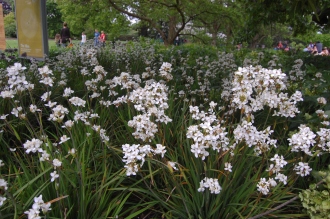Position: Full sun to light shade
Flowering period: Late spring to early summer
Soil: Moist, well drained
Eventual Height: 90cm
Eventual Spread: 50cm
Hardiness: 4a, 4b, 5a, 5b, 6a, 6b, 7a, 7b, 8a, 8b, 9a, 9b
Family: Iridaceae
Iris sibirica ‘Perry’s Blue’ is a deciduous herbaceous perennial with an erect clump forming habit. Its grey/ green leaves are lanceolate with entire margins and gradually narrowing to a point, up to 80cm long and 4cm broad at their base. Its blue/ pale purple hermaphrodite flowers are up to 7cm across, emerge from a branched stem which emerges from the base of the leaf cluster. Its fruit is a loculicidal capsule and up to 4cm long. Its roots are below ground rhizomes which allow this plant to steadily spread.
The species Iris sibirica, commonly known as the Siberian Iris or Siberian Flag, is native to Russia, east and central Europe and north east Turkey. In its native habitat it grows in damp woodlands and damp meadows.
The etymological root of the binomial name Iris is derived from the Greek word for a rainbow, referring to the wide variety of flower colours found among the many species. Sibirica is derived from the Latin meaning ‘from Siberia’.
The landscape architect may find Iris sibirica ‘Perry’s Blue’ useful as an attractive herbaceous perennial with pale blue flowers. It is suitable for planting in damp locations including boggy ground and stream margins.
Ecologically, Iris sibirica ‘Perry’s Blue’ flowers are attractive to pollinating insects, including bees.
Iris sibirica ‘Perry’s Blue’ prefers moist, fertile, well-drained soils. It tolerates most pH of soil. It will tolerate wet soils.
Iris sibirica ‘Perry’s Blue’ requires little maintenance. Large clumps may be divided in autumn.
![]()
Landscape Architecture













